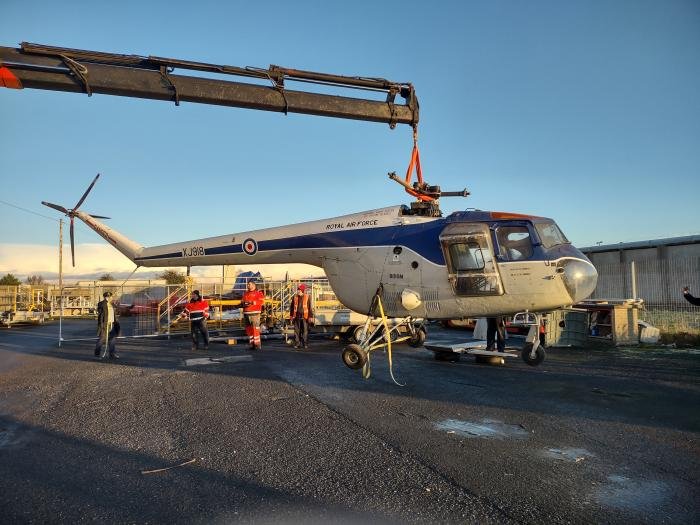
Gloster Meteor T7 (mod) WA634 and Bristol Sycamore HR14 XJ918 arrived at the Ulster Aviation Society’s base at Maze Long Kesh, Lisburn, on 9 December after being gifted by the RAF Museum. The two airframes had previously been in storage at the RAF Museum Midlands, Cosford.
UAS chairman and hangar manager Raymond Burrows says, “Our interest is always aroused whenever we seen a list of aircraft to be ‘gifted’ and the Meteor and Sycamore jumped out at us when we saw the recent RAF Museum list, the Meteor because of its use with Martin-Baker and the Sycamore because of the type’s service around here during the 1950s and ’60s. We were particularly interested in the Meteor because Martin-Baker has a test track here at the former RAF Langford Lodge, near Belfast, where they carry out live ejections.
“Plans for both include painting the Sycamore overall yellow, as they would have been when serving here, while we are looking at perhaps having a dummy ‘ejectee’ coming out of the rear cockpit of the Meteor. All in all, an exciting and busy year or two ahead.”
Built at Hucclecote, Gloucester during the autumn of 1949, after a period with the Aeroplane and Armament Experimental Establishment at Boscombe Down the Meteor went to the Martin-Baker Aircraft Company on loan for ejection seat trials during January 1951. M-B had requested a Meteor T7 to modify for testing the Mk3 high-speed ejection seat, intended for future use in supersonic aircraft. In April 1952, WA634 was returned to Gloster at Moreton Valence for the fitting of a Meteor F8 rear fuselage and tailplane, to solve ‘snaking’ problems the machine encountered at high speeds. After its return, again on loan to M-B, WA634 was dubbed a ‘Meteor 7½’.
On 11 March 1955 a dummy pilot was ejected using the Mk3 seat at low level from the rear cockpit of WA634 at Chalgrove, Oxfordshire. Sqn Ldr John S. Fifield was fired out of WA634 for the first live ground-level ejection on 3 September 1955, the modified Mk3 seat taking him up to a height of 70ft. His parachute opened at 30ft before Fifield alighted safely back at Chalgrove.
The aeroplane was used for runway ejection demonstrations during the 1958 Hanover airshow at Langenhagen, this time with German pilot Rolf Bullwinkel in the hot seat. October 1961 saw the loan period to Martin Baker extended for the umpteenth time, this time for testing new multiple-stage rocket-propelled ejection seats, which were intended to enable escape from high-speed aircraft at ground level and operational altitude. M-B finally acquired WA634 during September 1962, and operated it for a further five years before the final ejection seat test flight at Chalgrove on 12 December 1967.
Sycamore XJ918 was originally delivered to No 275 Squadron at Thornaby, Yorkshire on search and rescue duties. During 1959 it was transferred to the Far East Air Force in Malaya, and in October 1964, following the withdrawal of the Sycamore from front-line service, it was retained as the personal transport of the Air Officer Commanding FEAF. The helicopter went to the Metropolitan Communications Squadron at Northolt on 11 April 1968, finally being retired from use on VIP transport duties at the west London base with No 32 Squadron, part of Air Support Command, in July 1971. It passed to No 2 School of Technical Training at Cosford on 20 December 1971 as 8190M.


